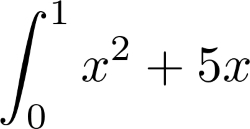The keyword lambda is used in Python to define anonymous functions, that is; functions without a name and described by a single expression. You might just want to perform an operation on a function that can be expressed by a simple expression without naming this function and without defining this function by a lengthy def block.
Note
The name lambda originates from a special branch of calculus and mathematical logic, the  -calculus.
-calculus.
For instance, to compute the following expression, we may use SciPy’s function quad, which requires the function to be integrated as its first argument and the integration bounds as the next two arguments:

Here, the function to integrate is just a simple one-liner and we use the lambda keyword to define it:
import scipy.integrate as si si.quad(lambda x: x ** 2 + 5, 0, 1)
The syntax is as follows:
lambda parameter_list: expression
The definition of the lambda function can only consist of a single expression and in particular...



